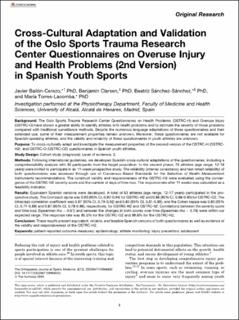| dc.contributor.author | Bailón-Cerezo, Javier | |
| dc.contributor.author | Clarsen, Benjamin Matthew | |
| dc.contributor.author | Sánchez-Sánchez, Beatriz | |
| dc.contributor.author | Torres-Lacomba, Mariá | |
| dc.date.accessioned | 2021-02-01T17:32:17Z | |
| dc.date.available | 2021-02-01T17:32:17Z | |
| dc.date.created | 2020-12-21T12:31:55Z | |
| dc.date.issued | 2020 | |
| dc.identifier.citation | Orthopaedic Journal of Sports Medicine. 2020, 8(12), 2325967120968552. | en_US |
| dc.identifier.issn | 2325-9671 | |
| dc.identifier.uri | https://hdl.handle.net/11250/2725682 | |
| dc.description | This open-access article is published and distributed under the Creative Commons Attribution - NonCommercial - No Derivatives License (https://creativecommons.org/licenses/by-nc-nd/4.0/), which permits the noncommercial use, distribution, and reproduction of the article in any medium, provided the original author and source are credited. You may not alter, transform, or build upon this article without the permission of the Author(s). | en_US |
| dc.description.abstract | Background: The Oslo Sports Trauma Research Center Questionnaires on Health Problems (OSTRC-H) and Overuse Injury (OSTRC-O) have shown a greater ability to identify athletes with health problems and to estimate the severity of those problems compared with traditional surveillance methods. Despite the numerous language adaptations of these questionnaires and their extended use, some of their measurement properties remain unknown. Moreover, these questionnaires are not available for Spanish-speaking athletes, and the validity and reliability of these questionnaires in youth athletes are unknown.
Purpose: To cross-culturally adapt and investigate the measurement properties of the second version of the OSTRC-H (OSTRC-H2) and OSTRC-O (OSTRC-O2) questionnaires in Spanish youth athletes.
Study Design: Cohort study (diagnosis); Level of evidence, 2.
Methods: Following international guidelines, we developed Spanish cross-cultural adaptations of the questionnaires, including a comprehensibility analysis with 30 participants from the target population. In the second phase, 73 athletes (age range, 12-18 years) were invited to participate in an 11-week prospective study. The reliability (internal consistency and test-retest reliability) of both questionnaires was assessed through use of Consensus-Based Standards for the Selection of Health Measurement Instruments recommendations. The construct validity and responsiveness of the OSTRC-H2 were evaluated using the convergence of the OSTRC-H2 severity score and the number of days of time loss. The response rate after 11 weeks was calculated as a feasibility indicator.
Results: Equivalent Spanish versions were developed. A total of 63 athletes (age range, 12-17 years) participated in the prospective study. The Cronbach alpha was 0.93 (95% CI, 0.92-0.94) for OSTRC-H2 and 0.88 (95% CI, 0.86-0.90) for OSTRC-O2. The intraclass correlation coefficient was 0.87 (95% CI, 0.79-0.92) and 0.85 (95% CI, 0.81-0.89), and the Cohen kappa was 0.80 (95% CI, 0.71-0.89) and 0.87 (95% CI, 0.78-0.96), respectively, for OSTRC-H2 and OSTRC-02. Correlations between the severity score and time loss (Spearman rho = 0.61) and between the changes in both scores over time (Spearman rho = 0.78) were within our expected range. The response rate was 95.5% for the OSTRC-O2 and 99.6% for the OSTRC-H2.
Conclusion: These results present equivalent, reliable, and feasible Spanish versions of both questionnaires as well as evidence of the validity and responsiveness of the OSTRC-H2. | en_US |
| dc.language.iso | eng | en_US |
| dc.subject | patient-reported outcome measures | en_US |
| dc.subject | epidemiology | en_US |
| dc.subject | athlete monitoring | en_US |
| dc.subject | injury prevention | en_US |
| dc.subject | adolescent | en_US |
| dc.title | Cross-cultural adaptation and validation of the Oslo Sports Trauma Research Center questionnaires on overuse injury and health problems (2nd version) in Spanish youth sports | en_US |
| dc.type | Peer reviewed | en_US |
| dc.type | Journal article | en_US |
| dc.description.version | publishedVersion | en_US |
| dc.rights.holder | © The Author(s) 2020 | en_US |
| dc.source.pagenumber | 9 | en_US |
| dc.source.volume | 8 | en_US |
| dc.source.journal | Orthopaedic Journal of Sports Medicine | en_US |
| dc.source.issue | 12 | en_US |
| dc.identifier.doi | 10.1177/2325967120968552 | |
| dc.identifier.cristin | 1862329 | |
| dc.description.localcode | Institutt for idrettsmedisinske fag / Department of Sports Medicine | en_US |
| dc.source.articlenumber | 2325967120968552 | en_US |
| cristin.ispublished | true | |
| cristin.fulltext | original | |
| cristin.qualitycode | 1 | |
